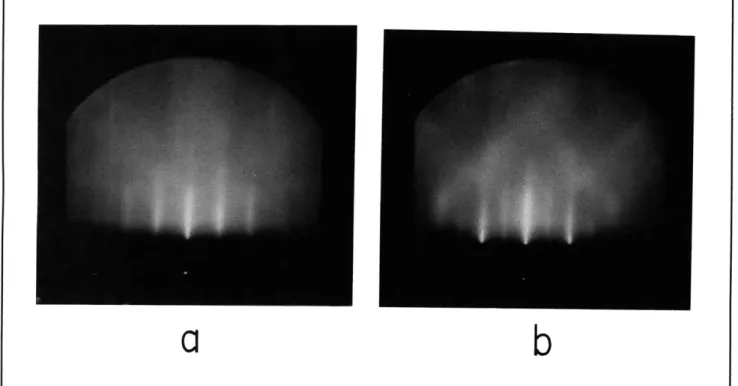Chapter 6. Chemical Beam Epitaxy of Compound Semiconductors
Chapter 6. Chemical Beam Epitaxy of Compound
Semiconductors
Academic and Research Staff
Professor Leslie A. Kolodziejski, Stephen C. Shepard Visiting Scientists and Research Affiliates
Dr. Hidehito Nanto,1 Dr. Carmen Huber2 Graduate Students
Christopher A. Coronado, Easen Ho Technical and Support Staff Angela R. Odoardi
6.1 Chemical Beam Epitaxy
Facility
Sponsors
3M Company Faculty Development Grant AT&T Research Foundation
Special Purpose Grant
Defense Advanced Research Projects Agency Subcontract 216-25013 and 542383 Joint Services Electronics Program
Contract DAAL03-89-C-0001 National Science Foundation
Grants ECS 88-46919 and ECS 89-05909 U.S. Navy - Office of Naval Research
Contract N00014-88- K-0564
Our new laboratory for the chemical beam epitaxy (CBE) of both II-VI and III-V compound semicon-ductors finally began to take the form of a working research facility in 1990. The substantial labora-tory renovation was completed in February; the
CBE system hardware was delivered in March and installed throughout most of the summer; ZnSe was deposited onto GaAs substrates in early August. However, the modular CBE system is not complete yet. We are anticipating delivery of the analytical/metalization chamber and a
Ill-V-dedicated gas source molecular beam epitaxy (GSMBE) system. Both chambers will be attached to the periphery of the ultrahigh vacuum (UHV) transfer chamber. Figure 1 shows the system footprint complete with all chambers which are currently expected. In the future, we plan to
add an in situ patterning chamber for further pro-cessing of the samples prior to removal from the UHV environment. The analytical metalization chamber will contain Auger Electron Spectroscopy, reflection high energy electron diffraction, electron beam evaporators for metals, and ports for photon illumination of the sample. The GSMBE system will be dedicated to the growth of arsenides, phosphides, and antimonides; solid elemental sources of In, Ga, Sb and Al will be utilized with gaseous hydrides of As and P. The chamber will be employed for the fabrication of sophisticated quantum-effect electronic devices, a variety of optoelectronic devices, and advanced II-VI/III-V multilayered heterostructures.
6.2 Metalorganic Molecular
Beam Epitaxy (MOMBE) of
ZnSe
Sponsors
Charles Stark Draper Laboratories Contract DL-H-418484
Defense Advanced Research Projects Agency Subcontract 542383
Joint Services Electronics Program Contract DAAL-03-89-C-0001 National Science Foundation
Grant ECS 88-46919
U.S. Navy - Office of Naval Research Contract N00014-88-K-0564
1 Department of Electronics, Kanazawa Institute of Technology, Kanazawa, Japan. 2 Physics Department, University of Puerto Rico, Rio Piedras, Puerto Rico.
Chapter 6. Chemical Beam Epitaxy of Compound Semiconductors
Figure 1. Layout of the CBE laboratory showing the footprint of the modular UHV system. The five chambers are the introduction, transfer, analytical/metalization, Il-VI CBE reactor, and Ill-V GSMBE reactor. Also indicated in the drawing is the wet chemical station for substrate preparation.
The II-VI semiconductor ZnSe is currently receiving considerable attention due to the recently reported success of p-type doping. Once ZnSe is successfully doped, both n- and p-type, various optical devices such as laser diodes, optical modulators, etc., can take advantage of the 2.67 eV bandgap to provide operation in the blue/blue-green portion of the spectrum. The most successful n-type dopant has been Cl with 1019 electron carrier concentrations reported for molecular beam epitaxy (MBE) growth. Thus far, incorporation of Li has been demonstrated to result in p-type ZnSe. Electrical measurements to confirm the presence of holes are complicated due to the small hole concentrations and the problem associated with forming ohmic contacts to p-type material. However, pn junctions formed in ZnSe have emitted blue light at room temperature. Due to significant problems of Li interdiffusion, investi-gations are currently focusing on incorporating dopant species other than Li to provide shallow acceptors. A potential candidate is nitrogen, although this volatile atom is difficult to incorpo-rate due to its small sticking coefficient and stable dimer bonding.
Our objective is to study controlled substitutional doping of ZnSe, both n- and p-type, by employing the growth technique of chemical beam epitaxy. CBE offers many advantages compared to MBE or metalorganic chemical vapor deposition and emphasizes the use of gaseous sources in an ultrahigh vacuum environment. In the CBE growth technique, the gaseous sources which are utilized
are both hydrides and metalorganics. It is anti-cipated that precise flux control of each specie via mass flow control of the gas will be a significant advantage in the growth of the high vapor pres-sure II-VI compounds.
We have grown ZnSe thin films on GaAs bulk sub-strates by metalorganic molecular beam epitaxy (MOMBE). MOMBE differs from CBE due to the absence of the gaseous hydride sources. The metalorganic gaseous sources which have been employed at present are diethylzinc (DEZn) and diethylselenide (DESe). In the growth exper-iments, the metalorganics are "cracked" or thermally decomposed prior to impingement onto the GaAs. The Zn and Se atoms are removed from the hydrogen and carbon atoms to allow the use of a lower growth temperature and to more closely approximate the MBE growth approach.
Figure 2 shows the reflection high energy electron diffraction pattern obtained from a 500A ZnSe film grown on GaAs. The presence of Kikuchi lines and a strongly streaked pattern suggest that the ZnSe is of high quality and single crystalline. The two-fold reconstruction lines observed in the [010] indicate a Zn-stabilized surface. For the growth of the thin ZnSe shown here, the substrate temperature was approximately 3000C with 1.0 and 0.30 sccm flow rates of DEZn and DESe, respectively. Investigations of the surface mor-phology with Nomarski interference microscopy has indicated the presence of a featureless surface at 1000x magnification. Additional experiments are in progress to increase the growth rate, as well
Chapter 6. Chemical Beam Epitaxy of Compound Semiconductors
Figure 2. Reflection high energy electron diffraction patterns obtained from a 500A ZnSe film grown on a (001) GaAs substrate. (a) [110] azimuth and (b) [010] azimuth.
as to investigate the growth using sources of dimethylzinc and hydrogen selenide.
6.3 Photon-assisted MOMBE of
Wide
Bandgap
II-VI
Compound
Semiconductors
Sponsors
Defense Advanced Research Projects Agency Subcontract 530-0716-07
National Science Foundation Grant ECS 88-46919
To achieve our objective of fabricating p-type ZnSe, we are employing state-of-the-art epitaxial growth techniques, such as CBE and MOMBE, to take advantage of the nonequilibrium nature of the growth. At the same time, we are employing a variety of coherent photon sources to illuminate a portion of the GaAs substrate during growth. Photon-assisted MBE of ZnSe has been demon-strated to have an effect on (1) the incorporation of various atoms, (2) the stoichiometry of the growing surface front, and (3) the density of defects. In our laboratory, the CBE reactor has viewports positioned so that a photon source can illuminate the substrate either perpendicular to or parallel to the surface. In our preliminary exper-iments, we have employed the visible 4579A line
of an argon ion laser perpendicular to the GaAs surface during MOMBE growth of ZnSe. The laser beam was defocused to partially illuminate a 1 cm diameter area of the wafer, providing a power density of approximately 100 mW/cm2. The power density is sufficiently low so that there was very little temperature increase. Following growth, no visible differences in the surface morphology were detected. However, a significant enhancement in the growth rate was observed from thickness measurements made by selectively etching away the ZnSe layer from the GaAs substrate. In the area illuminated by the laser, the growth rate was three times greater than in the area which was unilluminated. At the growth temperature of - 325°C, the wavelength of the laser is at an energy above that of the ZnSe bandgap. We are currently preparing experiments to study in detail the physical phenomena, for example electronic or photochemical, responsible for the growth rate enhancement.
The above mentioned results on the MOMBE of ZnSe, with and without photon assistance, are preliminary and not at all conclusive. These data represent the very first results on films grown by the MOMBE technique in our new CBE reactor. Additional microstructural, electrical, and optical characterizations of the ZnSe films are currently being prepared to provide further insight into the properties of this very important wide bandgap semiconductor.
Chapter 6. Chemical Beam Epitaxy of Compound Semiconductors
6.4 Publications
Kolodziejski, L. A. "Modern Growth Technologies of Semimagnetic Semiconductors." Paper pre-sented at the International School on Physics of Semiconducting Compounds, Jaszoweic,
Poland, April 1990.
Kolodziejski, L. A. "Chemical Beam Epitaxy for Advanced Optoelectronic Devices." Paper pre-sented at the Optical Society of America Meeting, Boston, Massachusetts, November 1990.

